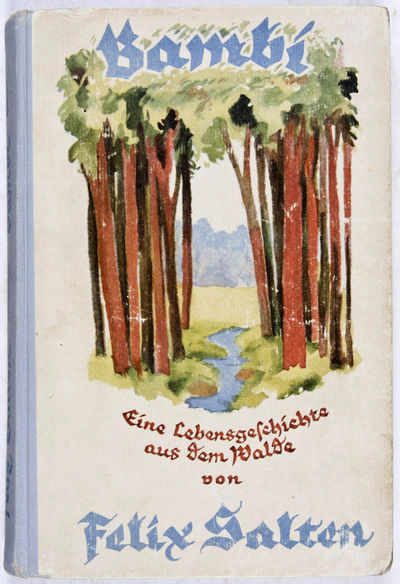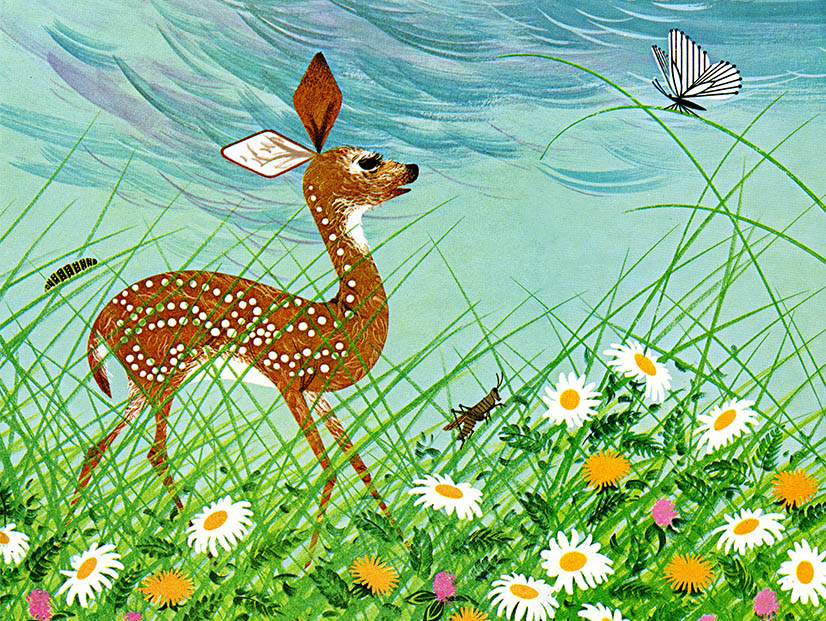In his lifetime, author Felix Salten straddled many worlds: as a hanger on to Hapsburg courts, a member of various Viennese literary circles, the author himself of what is reportedly one of the most depressing pornographic novels ever written (tracking down a reliable English translation is tricky), an occasional political activist, and a fierce Zionist. For financial reasons, he was barely able to attend school, much less enter a university program, but he considered himself an intellectual. He loved Vienna, but saved his deepest love for Austria’s mountains and forests, becoming an avid hiker and cyclist.
All of these blended together in his masterpiece, Bambi: A Life in the Woods, a deceptively simple story about a deer named Bambi and the animals he meets in the forest.
Bambi starts off quietly, with the birth of a little fawn in the woods. It is a happy moment for the fawn’s mother, a moment filled with birdsong and love, and yet, even here, some quiet, discordant notes are sounding. The different species of animals may be able to understand each other, but that doesn’t mean that they listen. The peace of the forest shelters the harsh cries of falcons and crows.
And although Bambi has his mother, he is at first completely isolated, unable to understand any of the voices that he hears. Slowly, his mother begins to introduce him to the forest, to the meadow, and to Him—the word, always capitalized, that the animals use for the human hunters in the woods. This includes explaining to Bambi what deer are (in a delightful passage that suggests that Salten also spent significant time not just with animals, but with three year old humans) and introducing him, bit by bit, to the concepts of beauty and danger and death. And, in a few short pages, to the idea of scarcity and hunger and fighting for food—even in a forest seemingly filled with abundance.
Bambi also meets other deer: his aunt Ena and her two children—Gobo, who is sickly, and Faline, a beautiful little deer who captures Bambi’s heart; Nettla, a cynical old deer with a caustic tongue; Ronno and Karus, two other young buck deer who become Bambi’s rivals; the various fathers, who sometimes run off with the mother deer, abandoning their children; and a majestic old stag, who knows something about Him. The deer also gossip about the other animals in the forest, particularly when those other animals die. And they discuss what, if anything, they can do about death.
As the seasons change into winter, food becomes scarce, and many of the animals weaken. The poignancy of this moment was probably heightened by Salten’s own memories: he had grown up poor and often hungry, and these passages have a harsh, bitter sharpness to them that almost certainly seems to be drawn from memory. Naturally, this is when He strikes, and many animals fall. Spring returns, with its abundance, as does life, and romance, and death.
And Him.
 On the surface, Bambi: A Life in the Woods, is just a simple story about animals and fathers who regularly abandon their children. (I’m willing to give deer a bit of a pass on this; Salten, possibly less so.) It is also a powerful and unapologetic anti-hunting story. Claims that Bambi helped lead to a population explosion of white-tailed deer in the U.S. are pretty excessive (and in any case, would probably be more the fault of the Disney film than the book), but the book is certainly not written to build sympathy towards hunters, and many readers have responded to the text by deciding to never eat meat again. And on a surface level, Bambi is a celebration of the forests that Salten loved so dearly (I almost wrote “deerly” there, forgive me).
On the surface, Bambi: A Life in the Woods, is just a simple story about animals and fathers who regularly abandon their children. (I’m willing to give deer a bit of a pass on this; Salten, possibly less so.) It is also a powerful and unapologetic anti-hunting story. Claims that Bambi helped lead to a population explosion of white-tailed deer in the U.S. are pretty excessive (and in any case, would probably be more the fault of the Disney film than the book), but the book is certainly not written to build sympathy towards hunters, and many readers have responded to the text by deciding to never eat meat again. And on a surface level, Bambi is a celebration of the forests that Salten loved so dearly (I almost wrote “deerly” there, forgive me).
But more than any of this, Bambi is a study, not of death and violence precisely, but the response to that death and violence. The deer are, for the most part, helpless against Him. Oh, certainly, as Gobo and the dogs demonstrate, they have the ability to cooperate, at least for a time, with the hunters—Gobo even becomes a well fed, adorable pet, which later helps him attract a young deer companion who has never quite believed that the hunters are bad. But this—spoiler alert—does not work out all that well for Gobo.
Nor are the hunters the only threat: in winter, many of the animals starve, or nearly starve. We get drawn out, detailed descriptions of other deaths from animal hunters: crows, falcons, ferrets, foxes. These deaths, too, are mourned by the animals, who eventually believe that “There was no longer either peace or mercy in the forest.” But the most terrifying threat remains Him.
That a murderous fox later faces his own death from Him is only small solace, especially since that scene is one of the most graphic in the book. Nor does it help that the animals know very little about Him: only legends and gossip and rumors. They aren’t even sure how many arms He has—some say two, some say three—with the third one able to spit out fire.
So how can the animals respond, given that they are no match for Him, and given that even without Him, they will inevitably die?
Some of the deer and the dogs suggest cooperating, and becoming pets—but that, as Gobo’s life demonstrates, is only a temporary solution. In an extraordinary passage, dying leaves try to convince themselves that they are still beautiful, that other things besides aging and winter can kill, and that they need to remember the sun. Bambi, meanwhile, abandons Faline and finds himself spending more and more time alone. This is, of course, partly a reflection of the actual habits of male roe deer, who do not typically remain with their mates or spend a lot of time with other animal species. But it’s also a sign of clinical depression, a typical response to feelings of helplessness. Bambi survives, but not undamaged.
These questions were ones that Salten, as a Jewish resident of late 19th century and early 20th century Vienna, pondered regularly. Keenly aware of the difficulties faced by many eastern European Jews—his own family left Budapest because of these difficulties—he was a Zionist, eager to help other Jews return to the Palestine area. But he did not, and could not assume that emigration was an option for all. He himself, with a life and friends in Vienna, did not move to Palestine. He fiercely argued against cultural assimilation, believing that Jews should celebrate their identities through the arts, and wrote texts for a general audience, and worked with the Hapsburg court.
It would be a bit too much, I think, to describe Bambi, as the Nazis later did when they banned it, purely as “a political allegory on the treatment of Jews in Germany.” (Their words, not mine). I think far more is going on here, particularly when it comes to discussions of death and survival.
But at least one part of Bambi is explicitly an argument against cultural assimilation with oppressors: no matter what the deer or other animals do, they remain, well, animals. Gobo’s story is perhaps the best example of this, but to drive home the point, Salten returns to it again in a passage late in the book, when several forest animals turn on a dog, accusing him—and cows, horses, and chickens—of being traitors, an accusation fiercely (and rather bloodily) denied by the dog, Salten has this:
“The most dreadful part of all,” the old stag answered, “is that the dogs believe what the hound just said. They believe it, they pass their lives in fear, they hate Him and themselves and yet they’d die for His sake.”
Perhaps no other part of Bambi reflects Salten’s politics more than this.
But perhaps no other part of Bambi reflects his beliefs more than the passage where Bambi and the old stag encounter a dead hunter in the woods, finding, finally, a touch of hope. The forest may be dangerous. But even in its wintery worst, even with hunters and foxes and magpies and crows, it is not dreadful, but beautiful. And death, Salten notes, is inevitable for all.
Even He.
In 1938, with Bambi: a Life in the Woods a proven international success, and the Disney film already in development, Salten was forced to flee from his home in Austria to the safety of neutral Switzerland, where he was able to see Disney’s animated version of his most famous novel. (He called it “Disney’s Bambi.”) He died there in 1945, before he could return home to his beloved forests in Austria, to spend quiet moments walking among the trees, looking for deer.
Mari Ness lives in central Florida.










